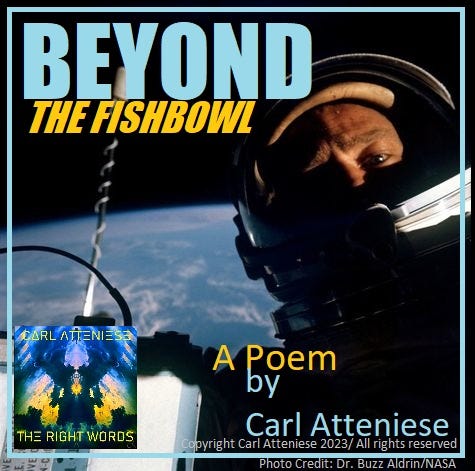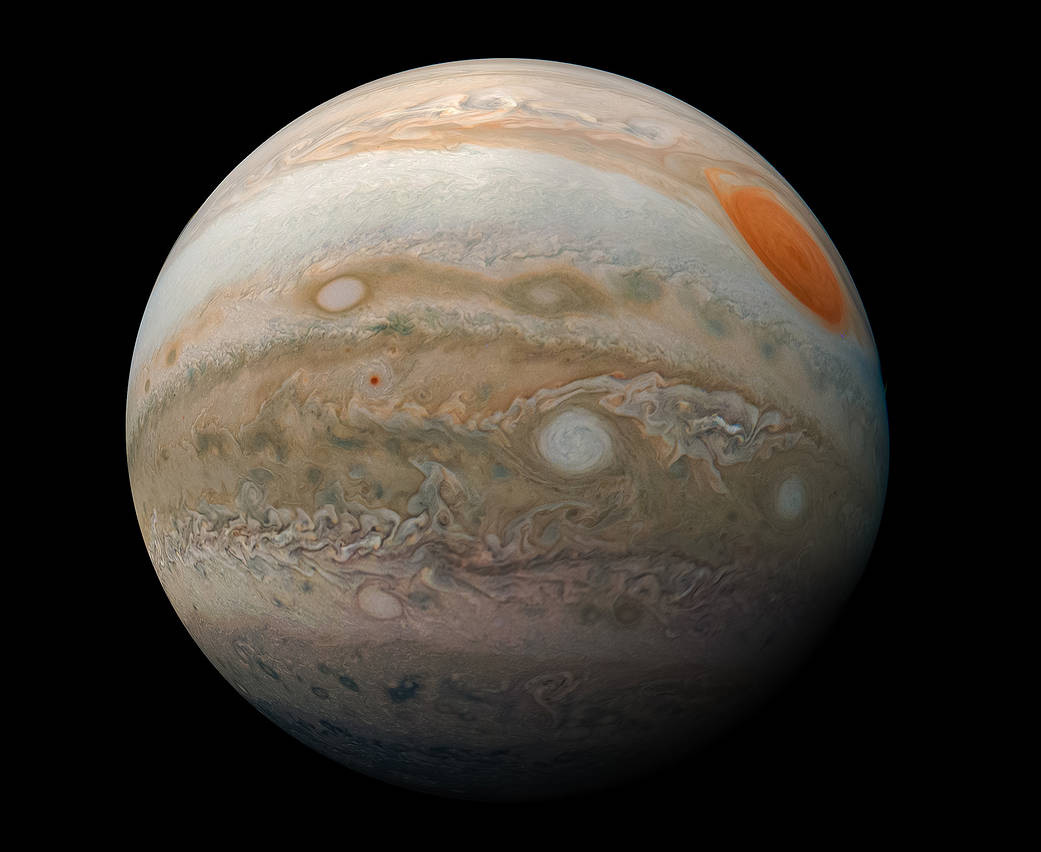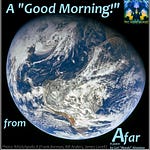
This poem can also be read here.
Beyond The Fishbowl
Crossfield flew across the barrier*
Then Shepard rocketed so high
And of Gagarin and Kamarov before them–
What did they feel?
Not ‘why?’
Truly, there is no membrane;
We live on a gas-ensconced globe,
Spinning and wobbling ’bout its axis
Barrelling in lock and roll
Circling a star–in turn racing
Round the galaxy’s swirling bright core
Itself shot out from the center
Venturing
By expansion thus far
. . .
All this violence in balance
Enormous–yet mutually constrained
Their motions play out like ice skaters
In a gliding dance of refrain
. . .
Armstrong & Aldrin first walked on the moon
With Cernan & Schmidt, the last two
On the face of that satellite ’til next time
They did what most should dream to
Because
We’re like fish in a fish bowl
Or children confined to a yard
The fish not knowing of oceans!
Nor the child of nations afar!
Until a day whence
One jumps the fence—
To glimpse the extent of the gloom
At an old age, but an Earth sage
May just see the limits of home
. . .
There are trillions of planets
Round trillions of stars
Yet those nearby
We’ve but seen from afar;
In our own system:
Two-hundred worlds,
Five dwarf planets,
A hundred-eighty-nine moons
. . .
Let’s see far neighbors!
The Jovian skies
With more than mere cameras!
With Man’s naked eye!
Like children and fishes,
Pets chained to rocks,
Moonshots—
Are feral*
Though great!
Man—
Goes
To the stars!
CA

This poem is in honor of all who have contributed to human flight—on and off the Earth (crewed and unmanned)—and in specific advocacy of expediting deep space missions to the outer planet systems—such as to the moons of Jupiter and Saturn, which potentially hold a much higher probability of sustaining life than does Mars. It is this writer’s contention that though far away—and requiring a staged mission-project-platform approach—such as those which enabled our success in the Apollo deep space missions—the economic, scientific, and inspirational benefits of human journeys to the gargantuan and heart-stopping beauty of the Saturnian and Jovian systems would be well worth the difficulty and effort and they are are not destinations which should wait fifty years—like the tragedy of our disrespectful delays in returning to the moon.
Happy Birthday Dr. Buzz Aldrin & Congratulations on your wedding to Dr. Faur! Many stellar years of happiness to you both!
Writing, Narration, Art, Production and Performance by & Copyright Carl Atteniese 2022/All rights reserved
Music Licensed from Pixabay:
1. Electronic Future Beats by Qubesounds
2. Cosmic Glow by Andrewkn
3. Astronaut and space-derived recordings courtesy of NASA Sounds
NOTE: The views you may glean from this work are my own and do not necessarily reflect those of whom I mention in the acknowledgements.
A C K N O W L E D G E M E N T S
Special Thanks to These Special Friends:
*Profile image of Carl………..Mark Longmire
*Founding Contributor…………..Hicham Derdari, Promoter
*Historical Consultant……………..Professor Lois Honeycutt
*Art Life Contributor……………….Professor Yukuhiro Yamaguchi
*Art Life Contributor……………….RMD, Musician, Teacher, Advisor
*Art Life Contributor……………....Professor Sahara Shin, Sponsor
*Art Life Contributor…………..…..Professor Harris Kim, Teacher, Sponsor
*Art Life Contributor……………....Alfred DiBlasi, Host of Alfred.TV, Sponsor
*Art life Contributor…………..…...Paul B. Kwak, Teacher, Sponsor
And for Great Support & Esteem from:
Mr. Carl Atteniese Sr., my loving father—airline facilitator electioneer, historian
Mrs. Anne Carroll Atteniese, my doting, loving mother & friend to all people
Charles XF Carroll (RIP), uncle, poet, friend, camera tech, soldier, sailor, gentleman
Mrs. Nancy Atteniese Gerber, my enormously supportive psychotherapist sister
Mrs. Mary Atteniese Pustarfi, my other enormously supportive and teacher sister
Mr. Jon Gerber, my brother-in-law& good friend—a scientist and family leader
Mrs. Lois Diefendorf, a great believer in my writing—writer
Mrs. Elizabeth Sgritta, my scholarly and supportive 9th grade English teacher
Mr. John Norris, my passionate 10th grade English teacher & encourager
Mrs. Stein, my kind but admonishing 11th grade English Teacher
And Special Thanks to…
The American tax-payer, the people in uniform and government who made and make our country possible and the family of NASA, SpaceX and their partners in the US and around the world—who make the greatest journeys of humanity happen—for all Mankind.
* Footnotes:
1. Scott Crossfield was an American aviator and test pilot—who, like Neil Armstrong and 7 others—earned astronaut wings for reaching the height of 50 miles—or roughly 80 kilometers—above the Earth, which the Air Force considers the threshold of outer space; this was accomplished in the X-15 rocket-plane. The international border between atmosphere and space, is, however, the Kármán line (after Theodore von Kármán), established by the at an altitude of 60 miles, or roughly 100 kilometers up. This is the boundary accepted by the United Nations, and where the physics dealt with between plane and spacecraft differ. Above this altitude, the air-dependent control surfaces of a plane will not function properly—as demonstrated in the famous scene from the film First Man, wherein Neil Armstrong’s character in his X-15, was at the mercy of the trajectory it was blasted into by its engine, traveling 3,000 miles per hour—with its pilot unable to use the control stick to guide it, until it descended into denser air. Like a spaceship, the X-15 was equipped with gas jets, like a spacecraft, to alter its pitch, yaw and roll attitude—but imprecise use of this recourse could be fatal.
2. I do not mean to suggest NASA was founded as a result of Yuri Gagarin’s flight; the history-making civilian aviation and spaceflight department of the US government was in operation before the gallant Russian’s historic launch into orbit.
3. I am taking license with the word ‘feral’, which I do not use meaning “wild,” “untamed” or “without civility”, but rather as meaning “nascent,” “basic,” “not enough” in the scope of what we are capable of—and in defiance of others who would say we shouldn’t do explore space; of course, the moon landings were the most difficult and monumental accomplishments in human ingenuity, intrepid, danger and exploration—and the men and women who made them happen are paramount heroes and historical figures of immense courage and ability…. It is precisely because of their sacrifice and daring—among the other reasons mentioned above—that I want us to go farther—sooner, in their names and memory.
Thank you for listening and reading.
CA












